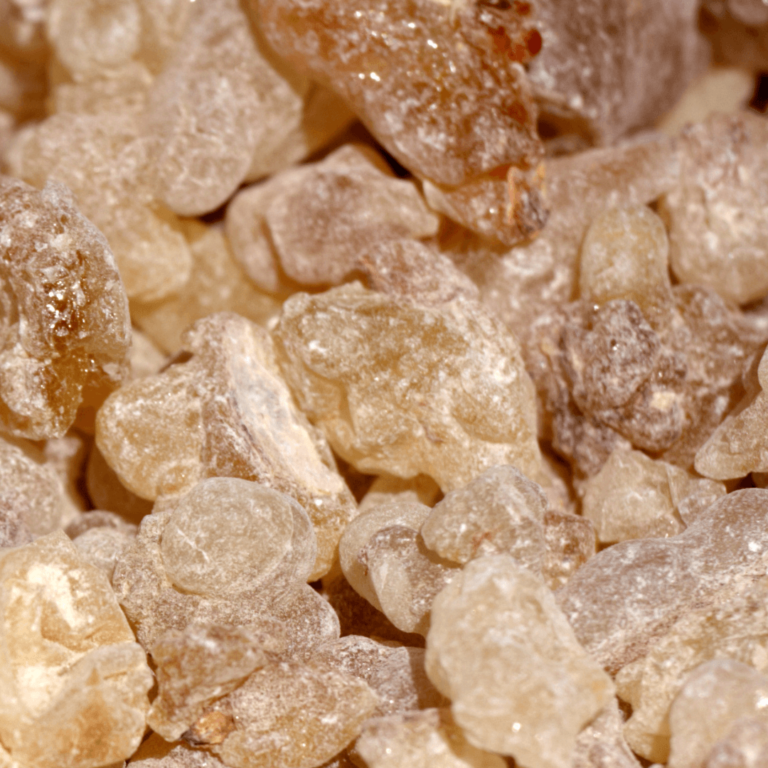Incense holds a privileged place in the world of fragrances, symbolizing spirituality and refinement. Its history dates back thousands of years, making it an integral part of many cultures worldwide. Used in religious rituals and perfume creation, incense has stood the test of time to become a prized ingredient. This article explores incense in perfumery through four essential aspects: its history, characteristics, extraction methods, and its use in perfumes.
The History of Incense
The Origin of Incense
By definition, the term “incense” refers to all gums and/or burnable materials. However, in perfumery, “incense” often specifically refers to frankincense, a resin obtained from the Boswellia tree.
Frankincense is primarily harvested in arid regions such as Oman, Yemen, Somalia, and parts of India. Since antiquity, people have used incense for its medicinal and sacred properties. Many civilizations considered it a precious offering to the gods, using it to purify the air and ward off evil spirits.
Incense held particular significance in Mesopotamian, Egyptian, and Indian cultures. In Egypt, priests burned incense to honor the gods and used it in funeral rituals, particularly in the mummification process. It is believed that the famous Queen Hatshepsut organized expeditions to bring incense from the Horn of Africa, particularly Somalia.
In India, Ayurvedic practitioners used incense for its purifying and spiritual properties. In China and Japan, incense played a role in the evolution of Buddhist religious culture. Eastern and Mediterranean civilizations regarded incense as a sacred resource, valued for both its therapeutic benefits and its fragrant qualities.
The Arrival in Europe
Incense reached Europe through trade routes, particularly the famous Incense Route, which connected the Middle East to the Roman Empire. Between the 3rd century BCE and the 2nd century CE, traders transported precious cargoes of incense and other resins across deserts to Europe.
During the Roman Empire, incense became highly sought after for religious ceremonies, as well as political and social rituals. Early Christianity quickly adopted this aromatic treasure, and by the Middle Ages, incense had become a central element of religious services. The Catholic Church extensively used incense in masses to symbolize prayers rising to heaven.
Later, incense made its way into European perfumery, particularly during the Renaissance when royal courts used it to create luxurious fragrances. It became an essential component of high-end French and Italian perfumery.
Incense in the Perfumery
Characteristics and Cultivation of Incense
Boswellia trees are well adapted to rocky soils and arid conditions. They grow on steep slopes, often in harsh environments where few other plants can survive. These trees begin producing resin around the age of 8 to 10 years.
Harvesting the resin is a long and delicate process. Farmers make incisions in the tree trunk, allowing a milky sap to seep out. This sap solidifies upon contact with air, forming droplets of resin. These “tears” of incense are then harvested about two months later. The collection process, which typically takes place between May and June, requires great expertise to avoid damaging the tree.
Incense Species used in perfumery
Incense is primarily sourced from trees of the Boswellia genus, with several species used for their fragrant resins. The most common varieties in perfumery include:
- Boswellia sacra : Native to Oman and Yemen, this species is considered the highest quality frankincense. It offers soft, spicy, and citrusy notes.
- Boswellia serrata : Widely found in India, this variety is used in both perfumes and Ayurvedic medicine.
- Boswellia frereana : Grown in Somalia, this incense variety is known for its particularly rich aroma and slightly harder texture.
The raw materials from Incense
After harvesting, the resin is cleaned and sorted based on its quality and color. The purer and lighter it is, the more valuable it becomes.
One of the most common methods for extracting raw materials from incense is steam distillation. This process involves heating the resin, which releases aromatic molecules carried by water vapor. The vapor is then condensed, producing essential oil.
In perfumery, incense can be used in two forms: essential oil or resinoid. The resinoid is obtained through solvent extraction from raw resin. The resulting product is dense and nearly solid, resembling caramel.
Incense from the Perfumer’s Perspective
Perfumers appreciate incense for its distinctive olfactory qualities. It is often described as mystical, soothing, spiritual, and meditative, giving it a sacred aura in the world of fragrance.
The scent profile of incense varies depending on its origin. For example, Omani frankincense (Boswellia sacra) tends to be softer and more citrusy, while Somali frankincense (Boswellia frereana), has spicier and woodier notes.
Perfumers frequently use incense as a base note in fragrance compositions due to its ability to add depth and longevity. It acts as an excellent fixative, enhancing the staying power of a perfume while harmonizing with other ingredients.
The essential oil of Incense is rising and powerful with aromatic notes of pine, hesperides of orange and spicy pepper. The resinoid is more stifled and rich with facets resinous and woody cedar atlas, both dry and smoked reminiscent of wood chips.
Some perfumes around the Incense note
- Opium – Yves Saint Laurent – 1977
- Encens Flamboyant – Goutal Parfums – 2007
- So Elixir – Yves Rocher – 2009
- Encens & Fève Tonka – Fragonard – 2013
- La Religieuse – Serge Lutens – 2015
- La Nuit Trésor – Lancôme – 2015
- Encens Suave – Matière Première – 2019
- Encens Rois – Histoires de Parfums – 2022

Did you like this article?
Share it on:

